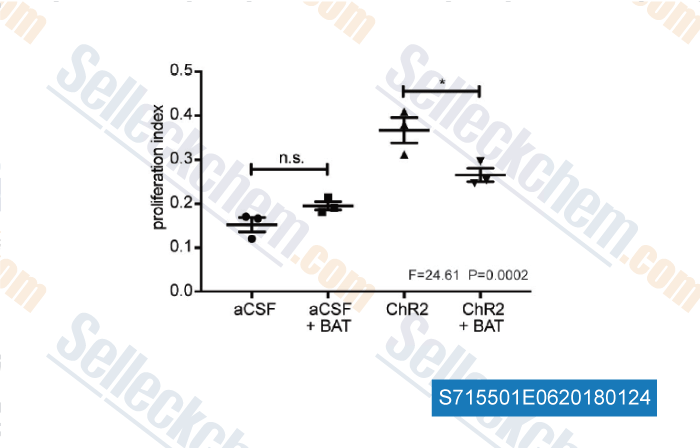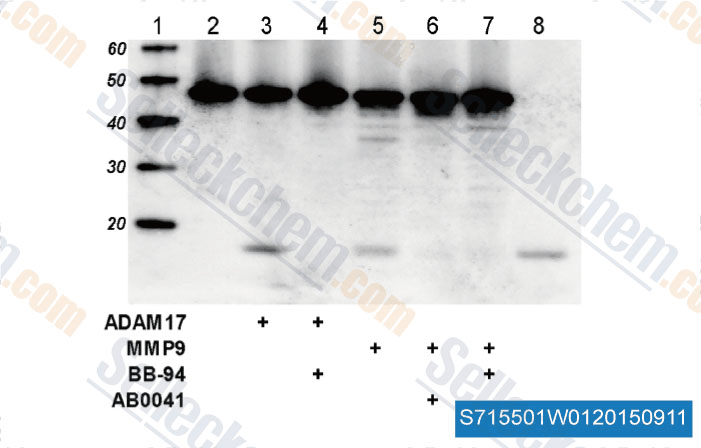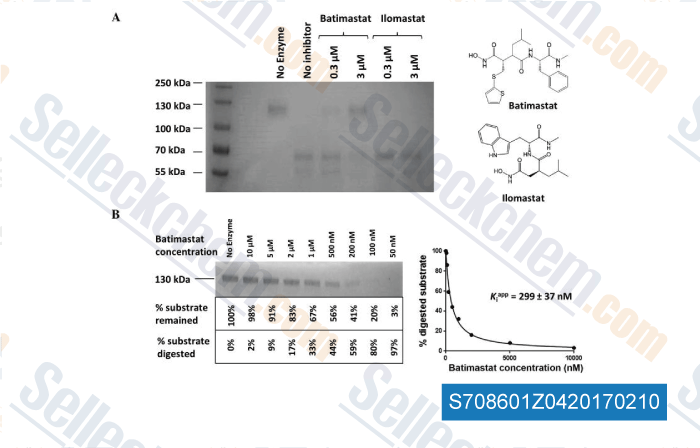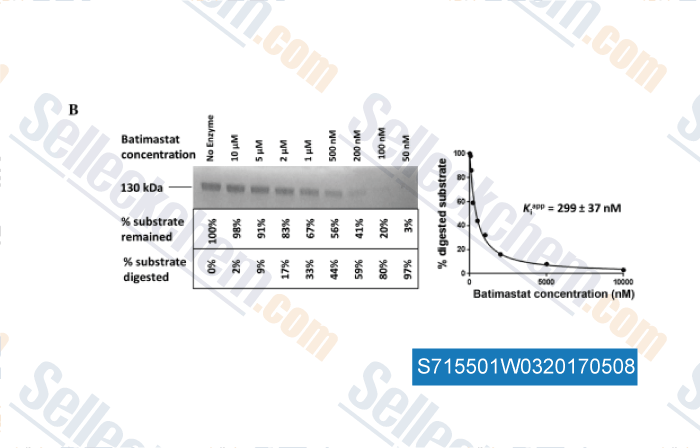|
Toll Free: (877) 796-6397 -- USA and Canada only -- |
Fax: +1-832-582-8590 Orders: +1-832-582-8158 |
Tech Support: +1-832-582-8158 Ext:3 Please provide your Order Number in the email. |
Technical Data
| Formula | C23H31N3O4S2 |
||||||||||
| Molecular Weight | 477.64 | CAS No. | 130370-60-4 | ||||||||
| Solubility (25°C)* | In vitro | DMSO | 96 mg/mL (200.98 mM) | ||||||||
| Water | Insoluble | ||||||||||
| Ethanol | Insoluble | ||||||||||
| In vivo (Add solvents to the product individually and in order) |
|
||||||||||
|
* <1 mg/ml means slightly soluble or insoluble. * Please note that Selleck tests the solubility of all compounds in-house, and the actual solubility may differ slightly from published values. This is normal and is due to slight batch-to-batch variations. * Room temperature shipping (Stability testing shows this product can be shipped without any cooling measures.) |
|||||||||||
Preparing Stock Solutions
Biological Activity
| Description | Batimastat (BB-94) is a potent, broad spectrum matrix metalloprotease (MMP) inhibitor for MMP-1, MMP-2, MMP-9, MMP-7 and MMP-3 with IC50 of 3 nM, 4 nM, 4 nM, 6 nM and 20 nM, respectively. Also inhibits the activitity of other metalloproteases, such as ADAM17. | ||||||||||
|---|---|---|---|---|---|---|---|---|---|---|---|
| Targets |
|
||||||||||
| In vitro | Batimastat (BB-94) is a potent, broad spectrum matrix metalloprotease (MMP) inhibitor for MMP-1, MMP-2, MMP-9, MMP-7 and MMP-3 with IC50 of 3 nM, 4 nM, 4 nM, 6 nM and 20 nM, respectively. [1] Batimastat exhibits an unexpected binding geometry, with the thiophene ring deeply inserted into the primary specificity site. [2] |
||||||||||
| In vivo | Batimastat can inhibit metastatic spread and growth of B16-BL6 murine melanoma. [1] In an orthotopic colon tumor model in mice, timastat treatment results in inhibition of primary tumor growth (by 50%), local/regional spread(from 67% to 35%), and distant metastasis(from 30% to 10%).[3] Batimastat reduces in vivo growth of experimental hemangiomas, most probably by blocking endothelial cell recruitment by the transformed cells or by interfering with cell organization in vascular structures. [4] |
Protocol (from reference)
| Kinase Assay: |
|
|---|---|
| Cell Assay: |
|
| Animal Study: |
|
References
|
Customer Product Validation

-
Data from [ , , Nature, 2017, 549(7673):533-537 ]

-
Data from [ , , PLoS One, 2015, 10(5): e0127063 ]

-
Data from [ , , Biomed Rep, 2016, 4(1):73-78. ]

-
Data from [ , , Biomed Rep, 2016, 4(1):73-78 ]
Selleck's Batimastat (BB-94) Has Been Cited by 39 Publications
| A pancreatic cancer organoid biobank links multi-omics signatures to therapeutic response and clinical evaluation of statin combination therapy [ Cell Stem Cell, 2025, S1934-5909(25)00265-6] | PubMed: 40812300 |
| The late-onset Alzheimer's disease risk factor RHBDF2 is a modifier of microglial TREM2 proteolysis [ Life Sci Alliance, 2025, 8(5)e202403080] | PubMed: 40081988 |
| UNC5B is an isoform-dependent target for ectodomain shedding [ J Biochem, 2025, mvaf043] | PubMed: 40631620 |
| Functional Differences Between SIRPα Splice Isoforms [ Genes Cells, 2025, 30(5):e70041] | PubMed: 40763927 |
| The Notch1 intracellular domain orchestrates mechanotransduction of fluid shear stress [ bioRxiv, 2025, 2025.07.13.663563] | PubMed: 40791532 |
| Omicron Spike confers enhanced infectivity and interferon resistance to SARS-CoV-2 in human nasal tissue [ Nat Commun, 2024, 15(1):889] | PubMed: 38291024 |
| Amino-terminally elongated Aβ peptides are generated by the secreted metalloprotease ADAMTS4 and deposit in a subset of Alzheimer's disease brains [ Neuropathol Appl Neurobiol, 2024, 50(3):e12991] | PubMed: 38867123 |
| Extracellularly Detectable Electrochemical Signals of Living Cells Originate from Metabolic Reactions [ Adv Sci (Weinh), 2023, e2207084.] | PubMed: 36737855 |
| FAP is critical for ovarian cancer cell survival by sustaining NF-κB activation through recruitment of PRKDC in lipid rafts [ Cancer Gene Ther, 2023, 30(4):608-621] | PubMed: 36494579 |
| Microphysiological model of PIK3CA-driven vascular malformations reveals a role of dysregulated Rac1 and mTORC1/2 in lesion formation [ Sci Adv, 2023, 9(7):eade8939] | PubMed: 36791204 |
RETURN POLICY
Selleck Chemical’s Unconditional Return Policy ensures a smooth online shopping experience for our customers. If you are in any way unsatisfied with your purchase, you may return any item(s) within 7 days of receiving it. In the event of product quality issues, either protocol related or product related problems, you may return any item(s) within 365 days from the original purchase date. Please follow the instructions below when returning products.
SHIPPING AND STORAGE
Selleck products are transported at room temperature. If you receive the product at room temperature, please rest assured, the Selleck Quality Inspection Department has conducted experiments to verify that the normal temperature placement of one month will not affect the biological activity of powder products. After collecting, please store the product according to the requirements described in the datasheet. Most Selleck products are stable under the recommended conditions.
NOT FOR HUMAN, VETERINARY DIAGNOSTIC OR THERAPEUTIC USE.
